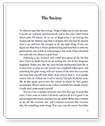Essay Instructions: I will be sending a draft character sketch essay via email. Enhance the essay using the notes below and markup included in the essay. You can take some creative license but remain consistent with the original essay. In other words, you can fictionalize, modify or expand on the events that take place as long as you remain true to the basic events described. You can completely ignore the last paragraph of the draft essay. Focus on the events that take place in the restaurant. The total length of the essay should be 500 to 700 words. Lines should be double spaced with the first line of each paragraph indented.
A few notes on characteristics of the essay:
Definition: As the title suggests, this work is a sketch, not a portrait, not a biography. It is limited in scope and intent. It does not presume to say that this is all that can be or should be said. It does say that this outline, this skeleton, this abbreviation is of a person worth knowing or knowing about.
Purpose: The writer attempts to share the experience of another person with others, sometimes to praise, sometimes to damn, frequently to understand better. The sketch can be for the writer, as for the visual artist, a voyage of discovery, noticing new features and traits and acknowledging known ones. The result may be as two dimensional and striking as the caricature or the cartoon or as revealing as the anatomical drawings of DaVinci. Wherever it may lead, the impulse to share our notions and perceptions of another human must be at least as strong or stronger than our urge to present other kinds of information. Consider how much talk in our day is about people: from the breathless junior high girl describing her latest infatuation to the irate senior describing the unpleasant driver on the freeway.
Considerations: Does the subject have an outstanding trait? Can you build up the detail, reveal the complexity of the person?
Stance: The person is the subject, not the writer. But the writer needs to be there--in the background, not the foreground. You do need to establish your connection to the subject. Try not to upstage your own subject. This is a character sketch, not a personal experience assignment. You cannot, because this is not fictional, tell us what the character is thinking or feeling, as if you are a kind of god-like, omniscient author. You can tell what you see and hear and what it makes you think might be going on.
Methods of Characterization:
Direct statement of a trait
"[Robert] Oppenheimer was an intellectual of broad interests and surprisingly disparate eruditions, who read the classics of Greek and Sanskrit and Spanish literature, loved poetry, carefully studied the work of Karl Marx to see for himself what was there. He was an epicure. * * * Leslie Groves was an engineer and a soldier, period."
--David Quammen
Reports from others
Grove's military deputy on the project said later: "He's the biggest sonovabitch I've ever met in my life, but also one of the most capable individuals . . . . I hated his guts and so did everybody else but we had our form of understanding."
--David Quammen
Effect on others
When Sunshine walked in, all the people in the room hoped he would not sit next to them.
--Student writer
Description
Use all the senses, not just sight. Do not be limited. Each sense has associations. For example, taste may be associated with certain foods a person enjoys or habitually eats; smell with a cologne the person wears.
"Groves was a large man, well upholstered in flesh. Robert Oppenheimer was gangly and emaciated."
--David Quammen
Dialog
"Democracy is not about being a damn spectator against the backdrop of tap-dancing politicians swinging in the winds of expediency."
--Congressman Ron Dellums.
"Call me Ishmael."
--Herman Melville, Moby Dick
More about dialog
Talk. Have others talk. Record the conversation of this person (carefully edited for tightness, of course) in your paper. Show in this assignment that you know how to present and punctuate dialog. Don't confuse good dialog with an actual record of the conversation (like a court reporter might do). You are not a court reporter, but an author. You recreate the feel of the person's speech, not the record of it. You do this by listening carefully and being selective. You look for speech characteristics: length of sentences, vocabulary, grammar, tone of voice, to mention a few.
A good way to begin writing dialog is to start a new paragraph with the speech. Open quotation marks, insert the utterance, insert the needed punctuation, close the quotation marks, finish with the speaker tag. Don't get fancy with speaker tags. Good ones are "said" and "asked." Not so good ones might include "inquired breathlessly" and "muttered murkily." By starting a new paragraph with the utterance, you avoid "burying" the dialog in the paragraph. Writers, even great writers, will bury dialog in the middle of paragraphs, but until you've worked with it for a while, it is usually more effective to handle dialog in separate paragraphs.
Some examples follow:
"Take your hand away from that gun and step into the light," Sam said.
"You don't have anything on me. I want my lawyer," Bennett said. "and I'll have you brought up on charges."
"I don't think so, especially after the chief sees these photos," Sam said.
There are faxes for this order.


